Accounting: Fair Value, Depreciation, Research and Development Costs, Provisions, Contingent Liabilities and Contingent Assets
VerifiedAdded on 2023/06/07
|9
|2174
|397
AI Summary
This article discusses the concepts of fair value, depreciation, research and development costs, provisions, contingent liabilities and contingent assets in accounting. It covers the relevant standards and provides examples to illustrate the concepts.
Contribute Materials
Your contribution can guide someone’s learning journey. Share your
documents today.
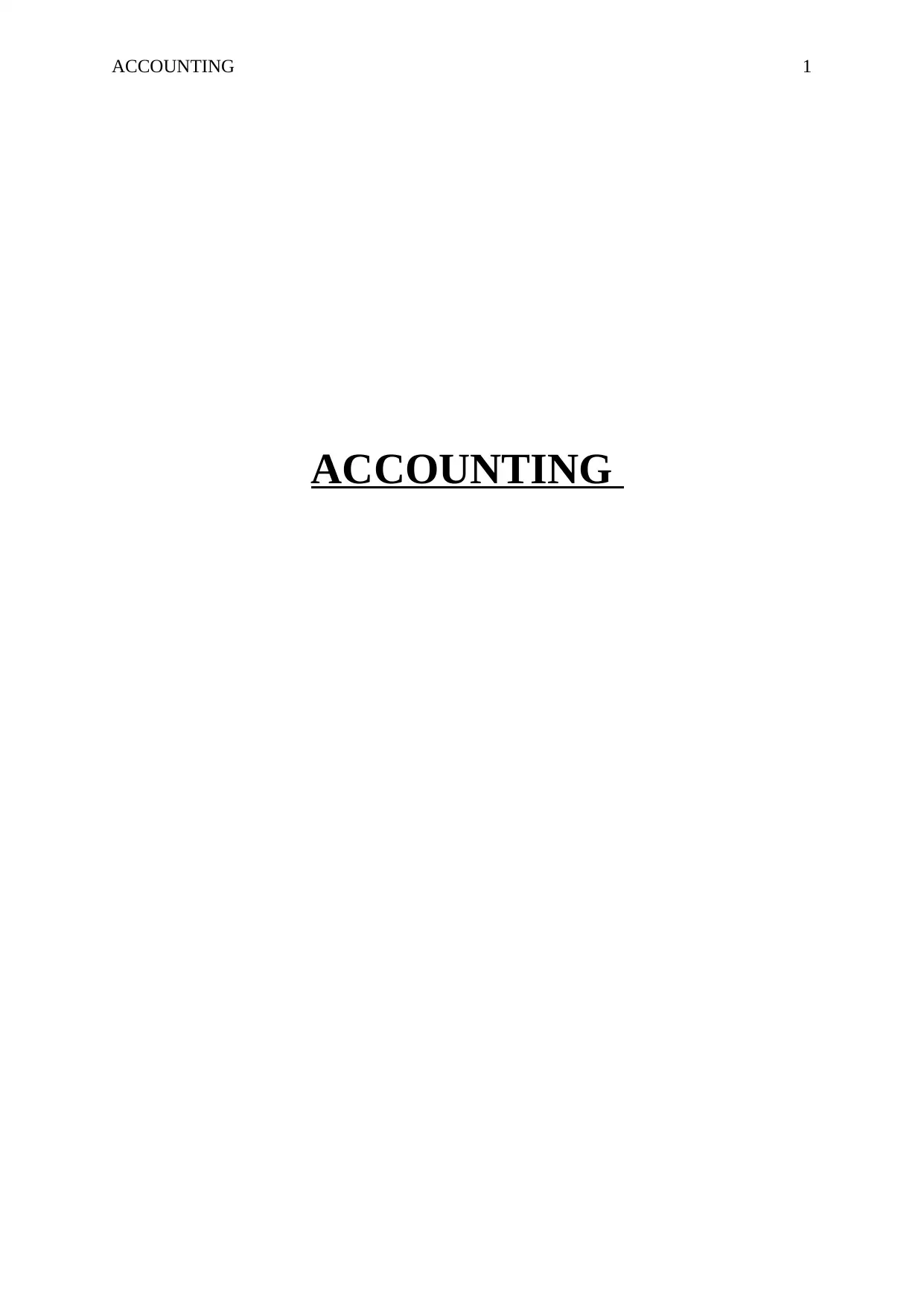
ACCOUNTING 1
ACCOUNTING
ACCOUNTING
Secure Best Marks with AI Grader
Need help grading? Try our AI Grader for instant feedback on your assignments.

ACCOUNTING 2
Question 1:
The concept of fair value is described as the price that would be received by the person if he
goes to the open market and sells his asset. Or the amount that he would have to pay in case,
he transfers a liability on to another in an apt manner between the different market
participants at any specified date. The following are the 4 key elements of the concept:
1. The asset or liability: this point takes into account whether the things being valued as
an asset or a liability. This would take into account the various characteristics when
the pricing of that asset or the liability would be done as on the date of measurement.
The examples could include in the condition and the location of that asset.
2. The transaction: this concept of fair value takes into account the fact that while
measuring in the fair value, the transaction would either by in the principal market for
that asset or liability or in the most advantageous market for that asset or liabilities, in
case that principal market is not there.
3. Participants in the market: the concept of the measurement of the fair value would
take into account the various different assumptions that any market participant would
consider when it comes to the pricing of that asset or the liability, assuming that the
participants of that market serve in the best interest of them.
4. The price: this is the price that anyone could receive if an asset is sold in the market
or if a liability is transferred in the ordinary course of trade. This is measured at the
current market conditions irrespective of the fact that the price is directly proportional
to the technique that is being used for the valuation of the same (AASB, 2018).
The following are the conditions that have to considered for the purposes of valuing a non
financial asset:
Question 1:
The concept of fair value is described as the price that would be received by the person if he
goes to the open market and sells his asset. Or the amount that he would have to pay in case,
he transfers a liability on to another in an apt manner between the different market
participants at any specified date. The following are the 4 key elements of the concept:
1. The asset or liability: this point takes into account whether the things being valued as
an asset or a liability. This would take into account the various characteristics when
the pricing of that asset or the liability would be done as on the date of measurement.
The examples could include in the condition and the location of that asset.
2. The transaction: this concept of fair value takes into account the fact that while
measuring in the fair value, the transaction would either by in the principal market for
that asset or liability or in the most advantageous market for that asset or liabilities, in
case that principal market is not there.
3. Participants in the market: the concept of the measurement of the fair value would
take into account the various different assumptions that any market participant would
consider when it comes to the pricing of that asset or the liability, assuming that the
participants of that market serve in the best interest of them.
4. The price: this is the price that anyone could receive if an asset is sold in the market
or if a liability is transferred in the ordinary course of trade. This is measured at the
current market conditions irrespective of the fact that the price is directly proportional
to the technique that is being used for the valuation of the same (AASB, 2018).
The following are the conditions that have to considered for the purposes of valuing a non
financial asset:
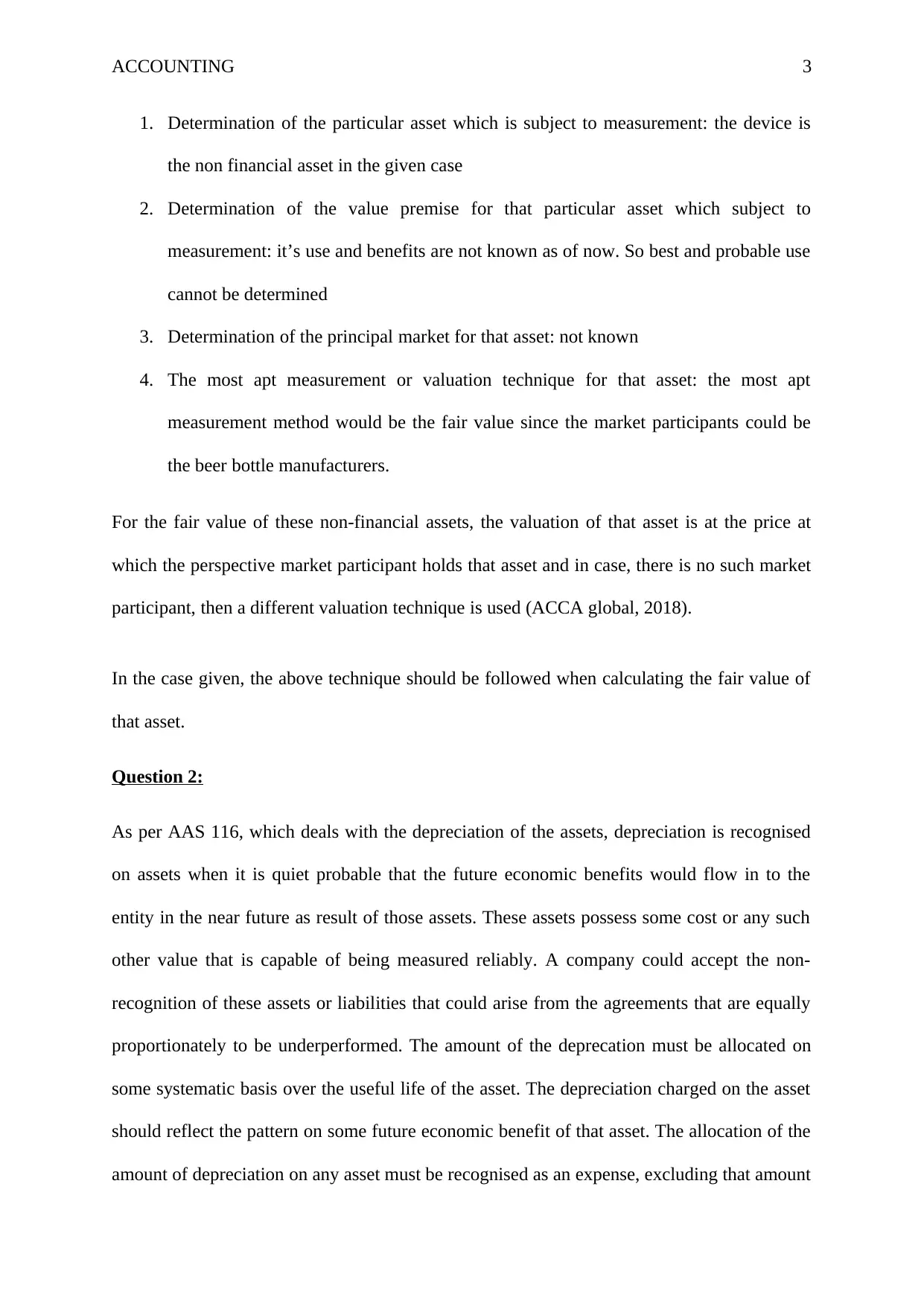
ACCOUNTING 3
1. Determination of the particular asset which is subject to measurement: the device is
the non financial asset in the given case
2. Determination of the value premise for that particular asset which subject to
measurement: it’s use and benefits are not known as of now. So best and probable use
cannot be determined
3. Determination of the principal market for that asset: not known
4. The most apt measurement or valuation technique for that asset: the most apt
measurement method would be the fair value since the market participants could be
the beer bottle manufacturers.
For the fair value of these non-financial assets, the valuation of that asset is at the price at
which the perspective market participant holds that asset and in case, there is no such market
participant, then a different valuation technique is used (ACCA global, 2018).
In the case given, the above technique should be followed when calculating the fair value of
that asset.
Question 2:
As per AAS 116, which deals with the depreciation of the assets, depreciation is recognised
on assets when it is quiet probable that the future economic benefits would flow in to the
entity in the near future as result of those assets. These assets possess some cost or any such
other value that is capable of being measured reliably. A company could accept the non-
recognition of these assets or liabilities that could arise from the agreements that are equally
proportionately to be underperformed. The amount of the deprecation must be allocated on
some systematic basis over the useful life of the asset. The depreciation charged on the asset
should reflect the pattern on some future economic benefit of that asset. The allocation of the
amount of depreciation on any asset must be recognised as an expense, excluding that amount
1. Determination of the particular asset which is subject to measurement: the device is
the non financial asset in the given case
2. Determination of the value premise for that particular asset which subject to
measurement: it’s use and benefits are not known as of now. So best and probable use
cannot be determined
3. Determination of the principal market for that asset: not known
4. The most apt measurement or valuation technique for that asset: the most apt
measurement method would be the fair value since the market participants could be
the beer bottle manufacturers.
For the fair value of these non-financial assets, the valuation of that asset is at the price at
which the perspective market participant holds that asset and in case, there is no such market
participant, then a different valuation technique is used (ACCA global, 2018).
In the case given, the above technique should be followed when calculating the fair value of
that asset.
Question 2:
As per AAS 116, which deals with the depreciation of the assets, depreciation is recognised
on assets when it is quiet probable that the future economic benefits would flow in to the
entity in the near future as result of those assets. These assets possess some cost or any such
other value that is capable of being measured reliably. A company could accept the non-
recognition of these assets or liabilities that could arise from the agreements that are equally
proportionately to be underperformed. The amount of the deprecation must be allocated on
some systematic basis over the useful life of the asset. The depreciation charged on the asset
should reflect the pattern on some future economic benefit of that asset. The allocation of the
amount of depreciation on any asset must be recognised as an expense, excluding that amount
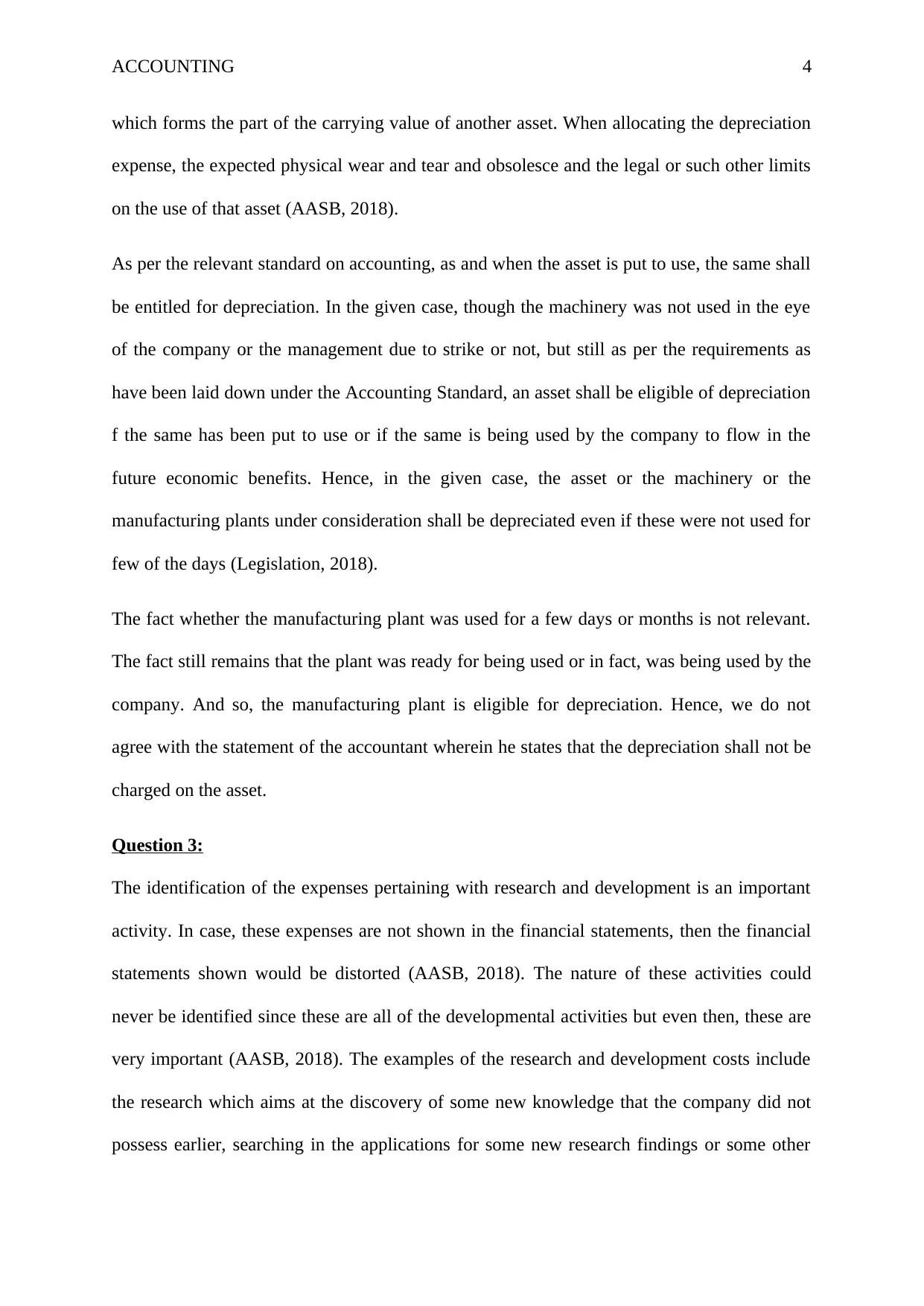
ACCOUNTING 4
which forms the part of the carrying value of another asset. When allocating the depreciation
expense, the expected physical wear and tear and obsolesce and the legal or such other limits
on the use of that asset (AASB, 2018).
As per the relevant standard on accounting, as and when the asset is put to use, the same shall
be entitled for depreciation. In the given case, though the machinery was not used in the eye
of the company or the management due to strike or not, but still as per the requirements as
have been laid down under the Accounting Standard, an asset shall be eligible of depreciation
f the same has been put to use or if the same is being used by the company to flow in the
future economic benefits. Hence, in the given case, the asset or the machinery or the
manufacturing plants under consideration shall be depreciated even if these were not used for
few of the days (Legislation, 2018).
The fact whether the manufacturing plant was used for a few days or months is not relevant.
The fact still remains that the plant was ready for being used or in fact, was being used by the
company. And so, the manufacturing plant is eligible for depreciation. Hence, we do not
agree with the statement of the accountant wherein he states that the depreciation shall not be
charged on the asset.
Question 3:
The identification of the expenses pertaining with research and development is an important
activity. In case, these expenses are not shown in the financial statements, then the financial
statements shown would be distorted (AASB, 2018). The nature of these activities could
never be identified since these are all of the developmental activities but even then, these are
very important (AASB, 2018). The examples of the research and development costs include
the research which aims at the discovery of some new knowledge that the company did not
possess earlier, searching in the applications for some new research findings or some other
which forms the part of the carrying value of another asset. When allocating the depreciation
expense, the expected physical wear and tear and obsolesce and the legal or such other limits
on the use of that asset (AASB, 2018).
As per the relevant standard on accounting, as and when the asset is put to use, the same shall
be entitled for depreciation. In the given case, though the machinery was not used in the eye
of the company or the management due to strike or not, but still as per the requirements as
have been laid down under the Accounting Standard, an asset shall be eligible of depreciation
f the same has been put to use or if the same is being used by the company to flow in the
future economic benefits. Hence, in the given case, the asset or the machinery or the
manufacturing plants under consideration shall be depreciated even if these were not used for
few of the days (Legislation, 2018).
The fact whether the manufacturing plant was used for a few days or months is not relevant.
The fact still remains that the plant was ready for being used or in fact, was being used by the
company. And so, the manufacturing plant is eligible for depreciation. Hence, we do not
agree with the statement of the accountant wherein he states that the depreciation shall not be
charged on the asset.
Question 3:
The identification of the expenses pertaining with research and development is an important
activity. In case, these expenses are not shown in the financial statements, then the financial
statements shown would be distorted (AASB, 2018). The nature of these activities could
never be identified since these are all of the developmental activities but even then, these are
very important (AASB, 2018). The examples of the research and development costs include
the research which aims at the discovery of some new knowledge that the company did not
possess earlier, searching in the applications for some new research findings or some other
Secure Best Marks with AI Grader
Need help grading? Try our AI Grader for instant feedback on your assignments.
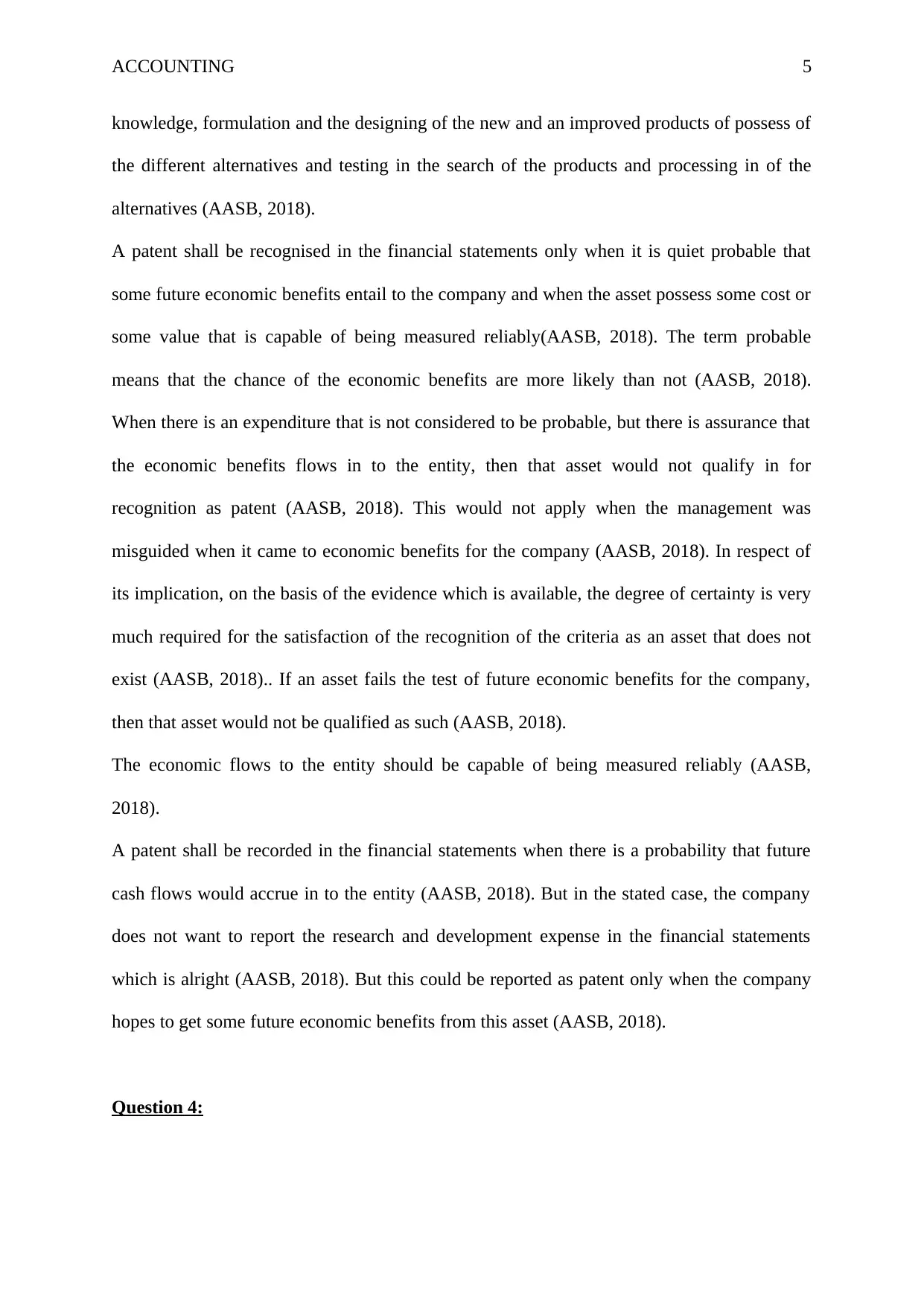
ACCOUNTING 5
knowledge, formulation and the designing of the new and an improved products of possess of
the different alternatives and testing in the search of the products and processing in of the
alternatives (AASB, 2018).
A patent shall be recognised in the financial statements only when it is quiet probable that
some future economic benefits entail to the company and when the asset possess some cost or
some value that is capable of being measured reliably(AASB, 2018). The term probable
means that the chance of the economic benefits are more likely than not (AASB, 2018).
When there is an expenditure that is not considered to be probable, but there is assurance that
the economic benefits flows in to the entity, then that asset would not qualify in for
recognition as patent (AASB, 2018). This would not apply when the management was
misguided when it came to economic benefits for the company (AASB, 2018). In respect of
its implication, on the basis of the evidence which is available, the degree of certainty is very
much required for the satisfaction of the recognition of the criteria as an asset that does not
exist (AASB, 2018).. If an asset fails the test of future economic benefits for the company,
then that asset would not be qualified as such (AASB, 2018).
The economic flows to the entity should be capable of being measured reliably (AASB,
2018).
A patent shall be recorded in the financial statements when there is a probability that future
cash flows would accrue in to the entity (AASB, 2018). But in the stated case, the company
does not want to report the research and development expense in the financial statements
which is alright (AASB, 2018). But this could be reported as patent only when the company
hopes to get some future economic benefits from this asset (AASB, 2018).
Question 4:
knowledge, formulation and the designing of the new and an improved products of possess of
the different alternatives and testing in the search of the products and processing in of the
alternatives (AASB, 2018).
A patent shall be recognised in the financial statements only when it is quiet probable that
some future economic benefits entail to the company and when the asset possess some cost or
some value that is capable of being measured reliably(AASB, 2018). The term probable
means that the chance of the economic benefits are more likely than not (AASB, 2018).
When there is an expenditure that is not considered to be probable, but there is assurance that
the economic benefits flows in to the entity, then that asset would not qualify in for
recognition as patent (AASB, 2018). This would not apply when the management was
misguided when it came to economic benefits for the company (AASB, 2018). In respect of
its implication, on the basis of the evidence which is available, the degree of certainty is very
much required for the satisfaction of the recognition of the criteria as an asset that does not
exist (AASB, 2018).. If an asset fails the test of future economic benefits for the company,
then that asset would not be qualified as such (AASB, 2018).
The economic flows to the entity should be capable of being measured reliably (AASB,
2018).
A patent shall be recorded in the financial statements when there is a probability that future
cash flows would accrue in to the entity (AASB, 2018). But in the stated case, the company
does not want to report the research and development expense in the financial statements
which is alright (AASB, 2018). But this could be reported as patent only when the company
hopes to get some future economic benefits from this asset (AASB, 2018).
Question 4:

ACCOUNTING 6
As per para 4.24–4.39, BC4.4–BC4.22 and BC4.45–BC4.81 of the Accounting standard, an
obligation or something that is derived in from the actions of the company by the established
pattern of the past practices, when there are published policies or a sufficiently specific
current statements and as the result of which the company has some valid expectation on the
part of the others.
A contingent liability is the possible obligation which arises from the events that have
occurred in the past and whose existence by the occurrence or the n-occurrence of one of
more of the future events are somewhat not certain but these are not recognised since it is not
quiet probable that the economic benefits that flows in to the entity would be required to
settle in the obligation. Also, it would be termed as the contingent liability when the same is
not capable of being measured reliably (AASB, 2018). A liability is something which has a
present obligation of the company which arises in from the past events and the same is
required to be settled of which there is an expectation of outflow of the resources of the
company entailing from the economic benefits.
A provision is something which is a liability of an uncertain timing or amount (IAS plus,
2018).
The following are the desired classifications:
Long service leave owing to the company’s employees in respect of past services is
estimated to total $1,250,000: this would be termed as a liability since this expenses arises
from the pasta activities to the company and there is an expectation that this would result
in a cash flow for the company
As per para 4.24–4.39, BC4.4–BC4.22 and BC4.45–BC4.81 of the Accounting standard, an
obligation or something that is derived in from the actions of the company by the established
pattern of the past practices, when there are published policies or a sufficiently specific
current statements and as the result of which the company has some valid expectation on the
part of the others.
A contingent liability is the possible obligation which arises from the events that have
occurred in the past and whose existence by the occurrence or the n-occurrence of one of
more of the future events are somewhat not certain but these are not recognised since it is not
quiet probable that the economic benefits that flows in to the entity would be required to
settle in the obligation. Also, it would be termed as the contingent liability when the same is
not capable of being measured reliably (AASB, 2018). A liability is something which has a
present obligation of the company which arises in from the past events and the same is
required to be settled of which there is an expectation of outflow of the resources of the
company entailing from the economic benefits.
A provision is something which is a liability of an uncertain timing or amount (IAS plus,
2018).
The following are the desired classifications:
Long service leave owing to the company’s employees in respect of past services is
estimated to total $1,250,000: this would be termed as a liability since this expenses arises
from the pasta activities to the company and there is an expectation that this would result
in a cash flow for the company

ACCOUNTING 7
The company’s machinery needs a complete overhaul every 5 years. The machinery was
5 years old as at 30 June 2018; The Company has estimated that the next overhaul will
cost $25, 000: a provision would be required for this sort of an expense since this expense
may or may not arise in future.
This expense since the amount is not yet fixed, should be liable for a provision. But as
soon as the amount has been decided, the same would be reported as a liability.
The company’s machinery needs a complete overhaul every 5 years. The machinery was
5 years old as at 30 June 2018; The Company has estimated that the next overhaul will
cost $25, 000: a provision would be required for this sort of an expense since this expense
may or may not arise in future.
This expense since the amount is not yet fixed, should be liable for a provision. But as
soon as the amount has been decided, the same would be reported as a liability.
Paraphrase This Document
Need a fresh take? Get an instant paraphrase of this document with our AI Paraphraser
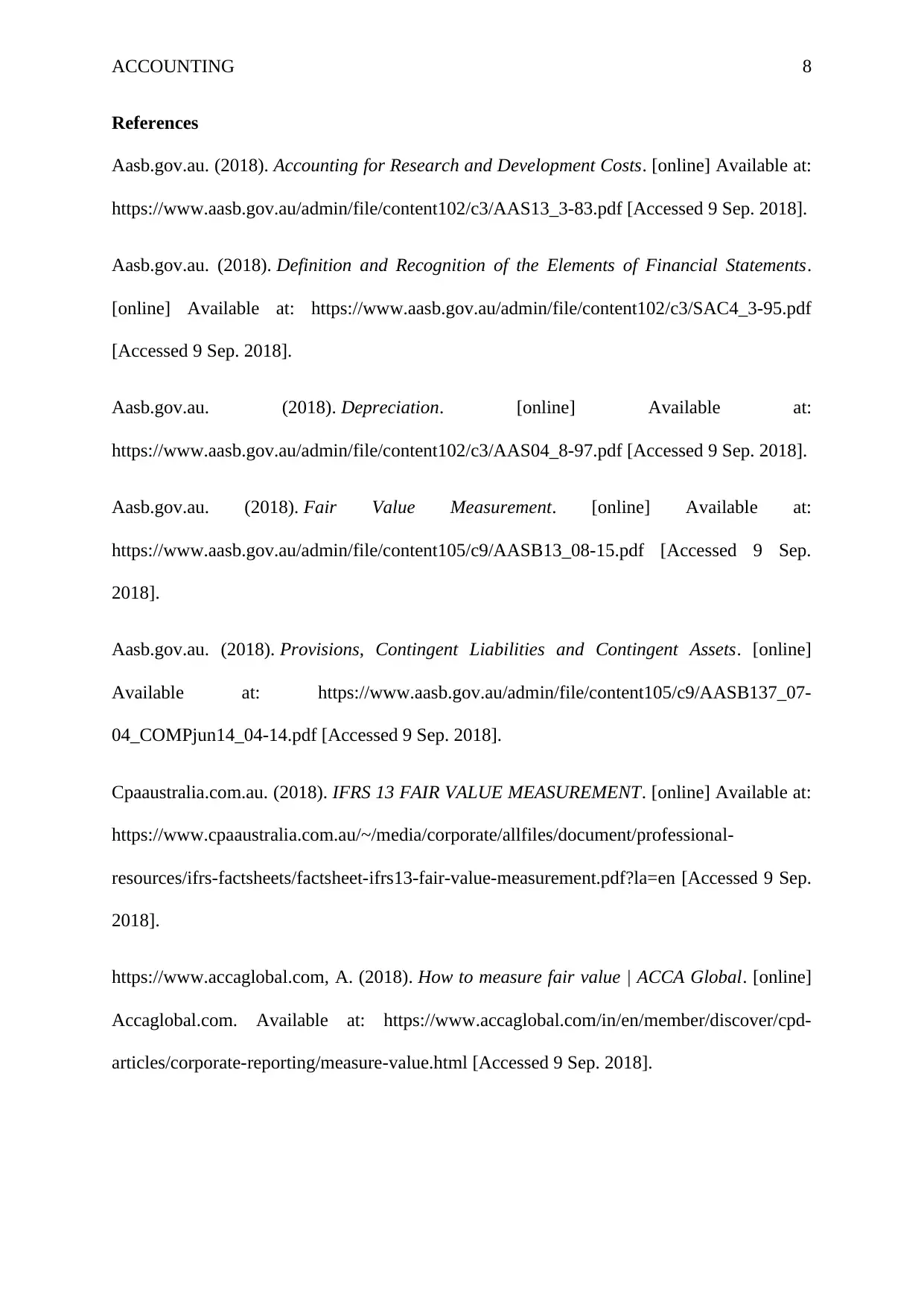
ACCOUNTING 8
References
Aasb.gov.au. (2018). Accounting for Research and Development Costs. [online] Available at:
https://www.aasb.gov.au/admin/file/content102/c3/AAS13_3-83.pdf [Accessed 9 Sep. 2018].
Aasb.gov.au. (2018). Definition and Recognition of the Elements of Financial Statements.
[online] Available at: https://www.aasb.gov.au/admin/file/content102/c3/SAC4_3-95.pdf
[Accessed 9 Sep. 2018].
Aasb.gov.au. (2018). Depreciation. [online] Available at:
https://www.aasb.gov.au/admin/file/content102/c3/AAS04_8-97.pdf [Accessed 9 Sep. 2018].
Aasb.gov.au. (2018). Fair Value Measurement. [online] Available at:
https://www.aasb.gov.au/admin/file/content105/c9/AASB13_08-15.pdf [Accessed 9 Sep.
2018].
Aasb.gov.au. (2018). Provisions, Contingent Liabilities and Contingent Assets. [online]
Available at: https://www.aasb.gov.au/admin/file/content105/c9/AASB137_07-
04_COMPjun14_04-14.pdf [Accessed 9 Sep. 2018].
Cpaaustralia.com.au. (2018). IFRS 13 FAIR VALUE MEASUREMENT. [online] Available at:
https://www.cpaaustralia.com.au/~/media/corporate/allfiles/document/professional-
resources/ifrs-factsheets/factsheet-ifrs13-fair-value-measurement.pdf?la=en [Accessed 9 Sep.
2018].
https://www.accaglobal.com, A. (2018). How to measure fair value | ACCA Global. [online]
Accaglobal.com. Available at: https://www.accaglobal.com/in/en/member/discover/cpd-
articles/corporate-reporting/measure-value.html [Accessed 9 Sep. 2018].
References
Aasb.gov.au. (2018). Accounting for Research and Development Costs. [online] Available at:
https://www.aasb.gov.au/admin/file/content102/c3/AAS13_3-83.pdf [Accessed 9 Sep. 2018].
Aasb.gov.au. (2018). Definition and Recognition of the Elements of Financial Statements.
[online] Available at: https://www.aasb.gov.au/admin/file/content102/c3/SAC4_3-95.pdf
[Accessed 9 Sep. 2018].
Aasb.gov.au. (2018). Depreciation. [online] Available at:
https://www.aasb.gov.au/admin/file/content102/c3/AAS04_8-97.pdf [Accessed 9 Sep. 2018].
Aasb.gov.au. (2018). Fair Value Measurement. [online] Available at:
https://www.aasb.gov.au/admin/file/content105/c9/AASB13_08-15.pdf [Accessed 9 Sep.
2018].
Aasb.gov.au. (2018). Provisions, Contingent Liabilities and Contingent Assets. [online]
Available at: https://www.aasb.gov.au/admin/file/content105/c9/AASB137_07-
04_COMPjun14_04-14.pdf [Accessed 9 Sep. 2018].
Cpaaustralia.com.au. (2018). IFRS 13 FAIR VALUE MEASUREMENT. [online] Available at:
https://www.cpaaustralia.com.au/~/media/corporate/allfiles/document/professional-
resources/ifrs-factsheets/factsheet-ifrs13-fair-value-measurement.pdf?la=en [Accessed 9 Sep.
2018].
https://www.accaglobal.com, A. (2018). How to measure fair value | ACCA Global. [online]
Accaglobal.com. Available at: https://www.accaglobal.com/in/en/member/discover/cpd-
articles/corporate-reporting/measure-value.html [Accessed 9 Sep. 2018].
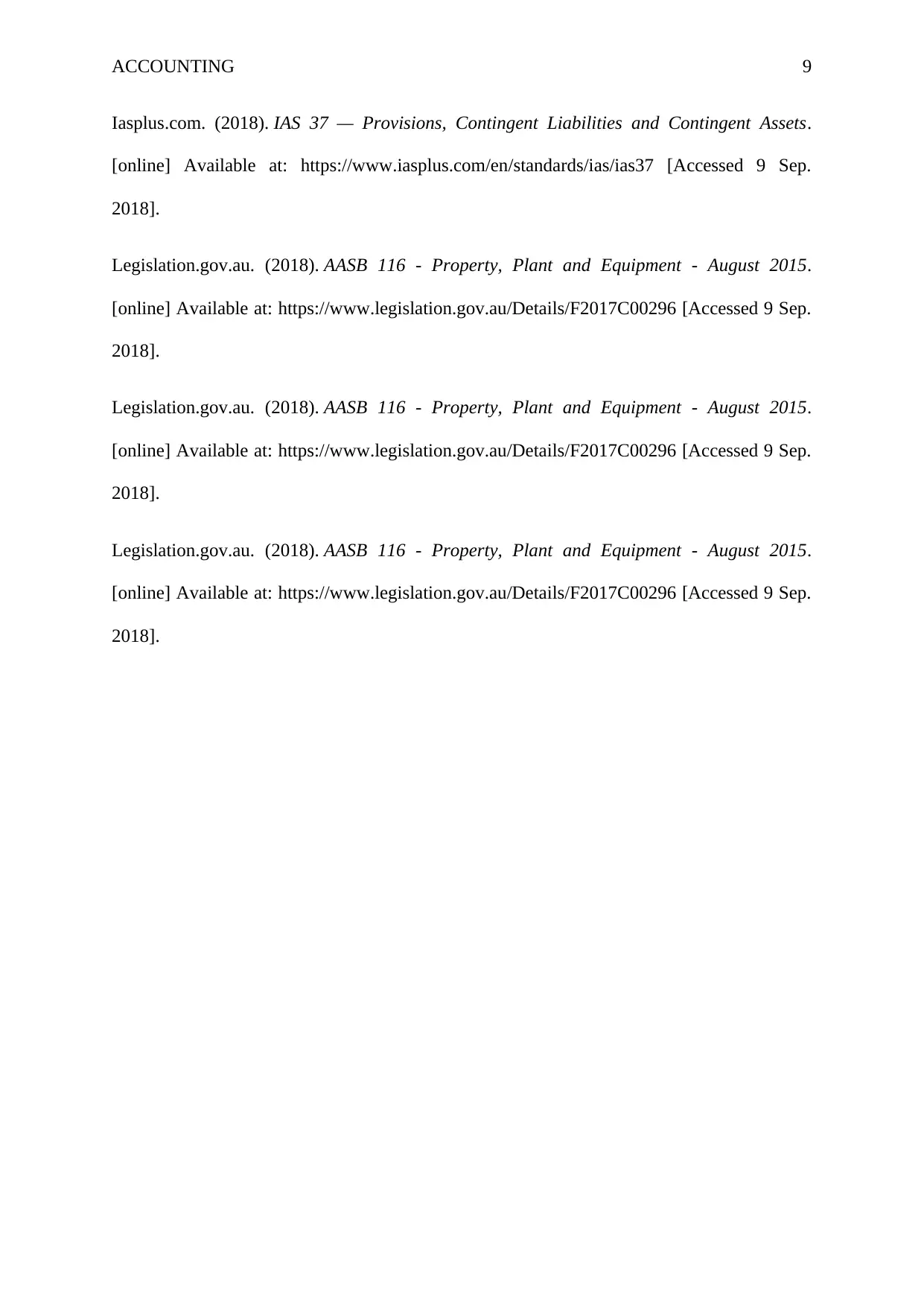
ACCOUNTING 9
Iasplus.com. (2018). IAS 37 — Provisions, Contingent Liabilities and Contingent Assets.
[online] Available at: https://www.iasplus.com/en/standards/ias/ias37 [Accessed 9 Sep.
2018].
Legislation.gov.au. (2018). AASB 116 - Property, Plant and Equipment - August 2015.
[online] Available at: https://www.legislation.gov.au/Details/F2017C00296 [Accessed 9 Sep.
2018].
Legislation.gov.au. (2018). AASB 116 - Property, Plant and Equipment - August 2015.
[online] Available at: https://www.legislation.gov.au/Details/F2017C00296 [Accessed 9 Sep.
2018].
Legislation.gov.au. (2018). AASB 116 - Property, Plant and Equipment - August 2015.
[online] Available at: https://www.legislation.gov.au/Details/F2017C00296 [Accessed 9 Sep.
2018].
Iasplus.com. (2018). IAS 37 — Provisions, Contingent Liabilities and Contingent Assets.
[online] Available at: https://www.iasplus.com/en/standards/ias/ias37 [Accessed 9 Sep.
2018].
Legislation.gov.au. (2018). AASB 116 - Property, Plant and Equipment - August 2015.
[online] Available at: https://www.legislation.gov.au/Details/F2017C00296 [Accessed 9 Sep.
2018].
Legislation.gov.au. (2018). AASB 116 - Property, Plant and Equipment - August 2015.
[online] Available at: https://www.legislation.gov.au/Details/F2017C00296 [Accessed 9 Sep.
2018].
Legislation.gov.au. (2018). AASB 116 - Property, Plant and Equipment - August 2015.
[online] Available at: https://www.legislation.gov.au/Details/F2017C00296 [Accessed 9 Sep.
2018].
1 out of 9
Related Documents
Your All-in-One AI-Powered Toolkit for Academic Success.
+13062052269
info@desklib.com
Available 24*7 on WhatsApp / Email
![[object Object]](/_next/static/media/star-bottom.7253800d.svg)
Unlock your academic potential
© 2024 | Zucol Services PVT LTD | All rights reserved.





